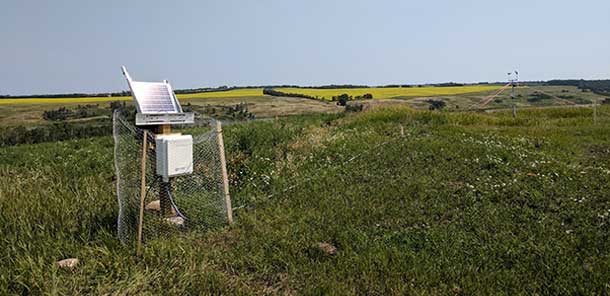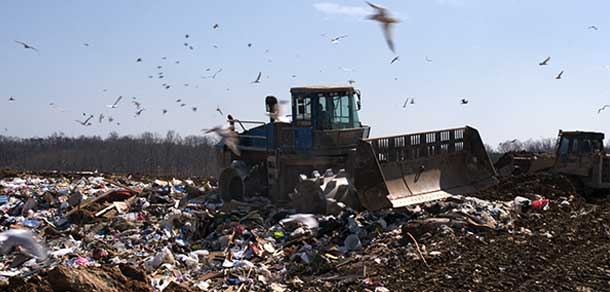
Evapotranspiration landfill biocovers are a potentially more efficient and effective method to reduce greenhouse gas emissions from landfills.
Should Tetra Tech Canada Inc. continue to experience success with its evapotranspiration landfill biocovers, that treasure could be shared globally in the form of greenhouse gas reduction.
unicipal landfills are notorious sources of greenhouse gas emissions. Canadian landfills account for 20 per cent of national methane emissions, with Alberta and Saskatchewan sitting comfortably among the top five provinces with the highest emissions.
In the U.S., landfills are the single largest man-made source of methane gas. Methane is approximately 25 times more effective at trapping heat in the atmosphere than the most prevalent greenhouse gas.
Tetra Tech Canada Inc. has a solution – evapotranspiration landfill biocovers (ETLBC). This is a potentially more efficient and effective method to reduce greenhouse gas emissions from landfills while meeting the requirements for alternative landfill cover.
Current practice in the waste industry is to use a standard final cover when airspace has been fully depleted in a landfill cell. This entails a three-layered approach that includes a clay barrier, a subsoil layer and a topsoil layer. Vegetation is the final layer added on top.
These cover systems act as a barrier to water infiltration, isolate underlying waste and meet regulatory requirements. For landfills that are large enough, landfill gas infrastructure is economically justified. However, the majority of landfills on the Canadian prairies are too small to justify the capital expenditure for an active landfill gas collection system.
“The evapotranspiration landfill biocover acts more like a sponge rather than a barrier,” explained Jerad Bech, P.Eng., project engineer at Tetra Tech Canada in Edmonton. “The premise is to hold on to the water and then release it over time rather than trying to create a succinct barrier between the climate and the waste.”
The standard cover acts as a barrier. Its goal is to prevent the infiltration of precipitation like rainfall or snowmelt. It works behind the premise of a clay barrier. Basically, the cover is designed to stop the water from migrating from the surface through the clay and into the underlying waste.
An ETLBC differs from a standard cover system by using landfill biocover technology to oxidize methane generated from waste degradation to allow for the creation of greenhouse gas offset credits.
Tetra Tech Canada used the Leduc Regional Landfill for a demonstration project. This was a team effort. Tetra Tech worked in conjunction with project partners, the Leduc and District Regional Waste Management Authority and the University of Calgary. Grant funding was provided by Emissions Reductions Alberta.
Of course, the inclusion of soils and topography required the expertise of geologists, who collaborated with Bech and Jeroen Pieterse, P.Eng, project manager at Tetra Tech Canada in Calgary. Hydrogeologists examined the modelling of layers and geophysical engineers provided insight on the slope stability.
“The engineering aspect with this project comes into play with the design of the covers,” Pieterse explained. “If you go with a standard traditional cover, you still need some design work. The landfills give you the requirements like the thickness of the clay and soil layers … basically, it comes down to finding the right soil, testing it and implementing it correctly.”
Having a variety of disciplines and background working together is nothing new for Tetra Tech Canada. Collaboration on projects is embraced and welcomed.
“If anything, as soon as I come across something that is outside of my wheelhouse, I prefer to have the access or the ability to talk to someone who really knows their stuff about the particular subject. Otherwise, you end up making things up,” Pieterse said.
“There are things you can look up online, but that doesn’t necessarily mean you understand it in the right context. You could apply something incorrectly.”
“Any time you’re working with people with further expertise in fields that we’re just scratching the surface on, it’s great to not be the smartest person in the room, especially in the context of this project,” Bech added.
“The amount of learning from others who can offer perspective on things that we didn’t see or didn’t consider was so great.”
With this being a demonstration project, the team had to provide considerable proof to the regulator (Alberta Environment and Parks) that the system could work as well or better than the standard cover. A rigorous design exercise included the construction of test plots at the Leduc landfill site.
The team built 30-metre by 30-metre demos of the technology and within them installed a sensor system to compare the ETLBC test plots and the already-installed clay cover on site.
The intent of the test plots was to provide data on the effectiveness of chosen biocover mix design, construction methodology and to measure methane oxidation rates to confirm that ETLBC would work in Alberta’s climate from both an alternative cover perspective and potential greenhouse gas emissions reductions, specifically:
- Performance equal to or better than a compacted clay cover.
- Methane oxidation rate of 60 per cent.
- Not susceptible to significant depth of frost penetrations.
The results of the demonstration project were promising. The cover performance exceeded the compacted clay cover system; methane oxidation was measured anywhere between 71-97 per cent; depth of frost penetration was estimated to be less than 300 mm.
“One of the larger goals of the project and the reason why we’re receiving grants is because of the potential for the greenhouse gas mitigation from this technology,” Pieterse said.
“Smaller landfills that can’t economically justify a gas extraction and utilization system are going to be candidates to use this technology and potentially generate offset credits.”
The demonstration project successfully received authorization from Alberta Environment and Parks for use of an ETLBC as an alternative cover system.
Alberta’s climate is similar to Saskatchewan’s, meaning an ETLBC could experience the same success in the neighbouring province.
“An ET cover is only going to be effective where your evapotranspiration exceeds your precipitation,” Bech explained. “You’ll see that in an arid or semi-arid climate. The majority of Alberta is semi-arid. It’s a good pre-screen to figure out where you can install these types of cover systems.”
ET covers were tested in B.C. as well. In the B.C. interior where the climate is semi-arid, the covers performed well. However, closer to the coastline where it is much wetter they did not receive the same high grades and the covers quickly reached a saturation point and developed leaks.
Optimized and well-adapted biocovers are relatively less expensive in terms of operation and installation compared to a conventional gas collection system, whose cost can be high compared to the value of the captured fuel.
These biocovers have low maintenance requirements and they can be maintained by a relatively untrained person. Thus, they are suitable for both high- and low-income countries.
There have been grants in Saskatchewan as well regarding landfills, specifically for rural municipalities needing to complete expensive environmental assessment studies on their landfill sites. At least 10 studies were conducted throughout the province between 2019-20. Tetra Tech was one of the recommended firms.
